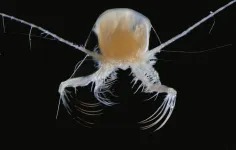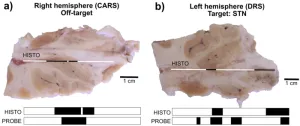(Press-News.org) Corneal transplants can be the last step to returning clear vision to many patients suffering from eye disease. Each year, approximately 80,000 corneal transplantations take place in the U.S. Worldwide, more than 184,000 corneal transplantation surgeries are performed annually.
However, rejection rates for the corneal grafts can be as high as 10%. This is largely due to poor patient compliance to the medications, which require frequent administrations of topical eyedrops over a long period of time.
This becomes especially acute when patients show signs of early rejection of the transplanted corneas. When this occurs, patients need to apply topical eyedrops hourly to rescue the corneal grafts from failure.
The tedious process of eyedrop dosing causes a tremendous burden for patients. The resulting noncompliance to medication treatment can lead to even higher graft-rejection rates.
Research led by a team at Virginia Commonwealth University may make the corneal grafts more successful by using nanoparticles to encapsulate the medication. The novel approach could significantly improve patient compliance, according to a paper recently published in Science Advances, “Six-month effective treatment of corneal graft rejection.”
Each nanoparticle encapsulates a drug called dexamethasone sodium phosphate, one of the most commonly used corticosteroids for various ocular diseases treatment such as ocular inflammation, non-infectious uveitis, macular edema and corneal neovascularization. By using the nanoparticles to control the release of the medicine over time, patients would require only one injection right after the corneal transplantation surgery without the frequent eye drops. Our studies have shown that using this method the medication maintains its efficacy for six months on a corneal graft rejection model.
In addition, because the medicine is released slowly and directly where it is most needed, the approach requires much lower doses than current standard eyedrop treatment while providing better efficacy and safety profiles.
Qingguo Xu, D.Phil., the principal investigator of this project and an associate professor of pharmaceutics and ophthalmology at VCU School of Pharmacy, collaborated with Justin Hanes, Ph.D., the Lewis J. Ort professor of ophthalmology at Johns Hopkins University.
Xu said, “To improve patient compliance and treatment efficacy, we developed a tiny nanoparticle (around 200 nanometers) that in animal studies enables the release of the drug up to six months after a single subconjunctival injection along the eyeball.”
Tuo Meng, Ph.D., who worked on the project as a doctoral student at VCU and is the first author of this paper, said: “In our preclinical corneal graft rejection model, the single dosing of the nanoparticle successfully prevented corneal graft rejection for six months.”
More importantly, the nanoparticle approach reversed signs of early rejection and maintained corneal grafts for six months without rejection.
This work was supported by the National Eye Institute, National Institutes of Health, through the R01 grant R01EY027827.
Xu’s lab focuses on developing nanotherapeutics for safer and more effective treatment of various eye diseases.
END
Tiny nanoparticle could have big impact on patients receiving corneal transplants
In studies, using nanoparticles to encapsulate eye medication decreased graft rejection while requiring fewer and smaller doses.
2023-03-24
ELSE PRESS RELEASES FROM THIS DATE:
Climate change threatens global fisheries
2023-03-23
The diet quality of fish across large parts of the world’s oceans could decline by up to 10 per cent as climate change impacts an integral part of marine food chains, a major study has found.
QUT School of Mathematical Sciences researcher Dr Ryan Heneghan led the study published in Nature Climate Change that included researchers from the University of Queensland, University of Tasmania, University of NSW and CSIRO.
They modelled the impact of climate change on zooplankton, an abundant and extremely diverse group of microscopic animals accounting for about 40 per cent ...
Dairy sector boasts 100 years of successful herd data collection
2023-03-23
URBANA, Ill. – The U.S. dairy industry operates a comprehensive data collection program that records herd production information from farmers nationwide. The program provides crucial input for cattle breeding and genetics, and its cooperative structure ensures benefits for producers and scientists alike. A new study from the University of Illinois explores the program’s century-old history, highlighting its relevance for modern agriculture and digital data collection.
“The National Cooperative Dairy Herd Improvement Program (NCDHIP) is an interesting case study because it illustrates how to translate the benefits ...
Study: Mapping people’s knowledge of bees may aid in pollinator conservation
2023-03-23
UNIVERSITY PARK, Pa. — U.S. college students’ knowledge of bees focuses primarily on honey bees and pollination services, according to Penn State researchers, who said findings from their recent study could help in designing campaigns to generate support for protecting threatened pollinators.
Wild and managed bee populations have been in steep decline worldwide in recent years, noted study co-author Christina Grozinger, Publius Vergilius Maro Professor of Entomology and director of the Center for Pollinator Research in ...
Spectroscopy probe could enhance deep brain stimulation procedure for Parkinson’s
2023-03-23
VANCOUVER -- Deep brain stimulation (DBS) has become an increasingly common treatment for patients with advanced Parkinson’s disease, but the procedure still carries significant risks. A new probe that performs two types of spectroscopy could make the procedure safer and improve success rates by helping doctors more accurately navigate instruments inside the brain. The research team identified white and grey matter using principal component analysis (PCA), proving that spectroscopic measurements could be suitable for neuronavigation.
For DBS, surgeons place electrodes in the brain to disrupt the errant signals that cause debilitating tremors and stiffness associated ...
Habitat will dictate whether ground beetles win or lose against climate change
2023-03-23
UNIVERSITY PARK, Pa. — The success of North American crops from corn to Christmas trees partly depends on a relatively invisible component of the food web — ground beetles. Nearly 2,000 species of ground beetle live in North America. New research led by Penn State shows that some of these insects could thrive while others could decline as the climate changes. The team found that the response will largely depend on the species’ traits and habitats and could have significant implications for conservation efforts.
“We know that climate change influences everything from coral reefs in the ocean to trees on land, but there’s ...
CDC report shows overall and Maryland autism rate increase among 8-year-olds
2023-03-23
Researchers at the Johns Hopkins Bloomberg School of Public Health contributed to a new Centers for Disease Control and Prevention report that found a continued rise in the overall prevalence of autism among 8-year-olds in 2020, the year the data was collected, as well as notable sex and racial/ethnic trends. In Maryland, the autism rate among 8-year-olds also rose, but it was the lowest prevalence among 11 sites that contributed to the study.
Autism spectrum disorder (ASD) is a developmental disorder that can be characterized by social and communication challenges, along with limited interests and repetitive behaviors.
The prevalence of ASD has risen steadily ...
Court ruling on PrEP could lead to more than 2,000 HIV infections in the next year
2023-03-23
A recent U.S. federal court ruling that removes a requirement for employers to provide insurance coverage for the HIV prevention medications known as Pre-Exposure Prophylaxis, or PrEP, could result in more than 2,000 entirely preventable HIV infections in the coming year, according to a new study led by researchers at the Yale School of Public Health.
The study addresses the potential consequences of a September 2022 decision by U.S. District Judge Reed O’Connor of Texas in a case known as Braidwood Management v. Becerra. O’Connor ruled in favor of the plaintiffs, a group of Christian business owners who claimed that federal mandates requiring private insurance ...
USC Norris collaborates with Auransa on clinical trial of new targeted treatment for liver cancer and other solid tumors
2023-03-23
The University of Southern California (USC) is collaborating with Auransa Inc., on a phase 1 clinical trial to evaluate a new kind of treatment for cancers of the liver and solid tumors with liver dominant disease. The drug, known as AU409, was developed by Auransa, a clinical stage drug development company focused on identifying novel drug candidates for oncology, inflammatory diseases and diseases of the central nervous system. In preclinical trials, AU409, has been shown to work in a unique fashion by limiting the cancer cell’s ability to translate the message from various genes ...
Global natural history initiative builds groundbreaking database to address 21st century challenges
2023-03-23
March 23, 2023 – Washington, DC, New York, NY, and London, England – A group of natural history museums, organized by the Smithsonian National Museum of Natural History in Washington DC, the American Museum of Natural History Museum in New York City, and the Natural History Museum in London, has mapped the total collections from 73 of the world’s largest natural history museums in 28 countries. This is the first step of an ambitious effort to inventory global holdings that can help scientists and decisionmakers find solutions to urgent, wide-ranging issues such as climate ...
Eye color genes are critical for retinal health
2023-03-23
Metabolic pathways consist of a series of biochemical reactions in cells that convert a starting component into other products. There is growing evidence that metabolic pathways coupled with external stress factors influence the health of cells and tissues. Many human diseases, including retinal or neurodegenerative diseases, are associated with imbalances in metabolic pathways. Elisabeth Knust leads a team of researchers from the Max Planck Institute of Molecular Cell Biology and Genetics (MPI-CBG) in Dresden, Germany, who describe an essential role for one ...
LAST 30 PRESS RELEASES:
Numbers in our sights affect how we perceive space
SIMJ announces global collaborative book project in commemoration of its 75th anniversary
Air pollution exposure and birth weight
Obstructive sleep apnea risk and mental health conditions among older adults
How talking slows eye movements behind the wheel
The Ceramic Society of Japan’s Oxoate Ceramics Research Association launches new international book project
Heart-brain connection: international study reveals the role of the vagus nerve in keeping the heart young
Researchers identify Rb1 as a predictive biomarker for a new therapeutic strategy in some breast cancers
Survey reveals ethical gaps slowing AI adoption in pediatric surgery
Stimulant ADHD medications work differently than thought
AI overestimates how smart people are, according to HSE economists
HSE researchers create genome-wide map of quadruplexes
Scientists boost cell "powerhouses" to burn more calories
Automatic label checking: The missing step in making reliable medical AI
Low daily alcohol intake linked to 50% heightened mouth cancer risk in India
American Meteorological Society announces Rick Spinrad as 2026 President-Elect
Biomass-based carbon capture spotlighted in newly released global climate webinar recording
Illuminating invisible nano pollutants: advanced bioimaging tracks the full journey of emerging nanoscale contaminants in living systems
How does age affect recovery from spinal cord injury?
Novel AI tool offers prognosis for patients with head and neck cancer
Fathers’ microplastic exposure tied to their children’s metabolic problems
Research validates laboratory model for studying high-grade serous ovarian cancer
SIR 2026 delivers transformative breakthroughs in minimally invasive medicine to improve patient care
Stem Cell Reports most downloaded papers of 2025 highlight the breadth and impact of stem cell research
Oxford-led study estimates NHS spends around 3% of its primary and secondary care budget on the health impacts of heat and cold in England
A researcher’s long quest leads to a smart composite breakthrough
Urban wild bees act as “microbial sensors” of city health.
New study finds where you live affects recovery after a hip fracture
Forecasting the impact of fully automated vehicle adoption on US road traffic injuries
Alcohol-related hospitalizations from 2016 to 2022
[Press-News.org] Tiny nanoparticle could have big impact on patients receiving corneal transplantsIn studies, using nanoparticles to encapsulate eye medication decreased graft rejection while requiring fewer and smaller doses.







